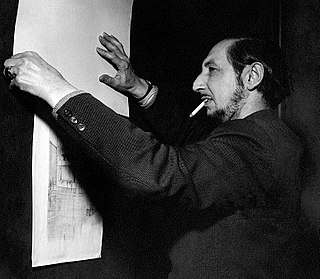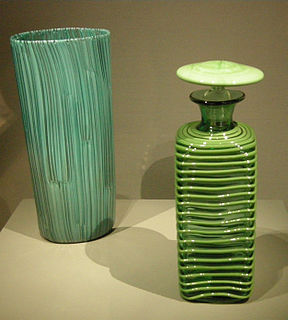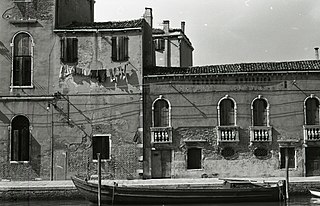Related Research Articles

Dale Chihuly is an American glass sculptor and entrepreneur. His works are considered to possess outstanding artistic merit in the field of blown glass, "moving it into the realm of large-scale sculpture." The technical difficulties of working with glass forms are considerable, yet Chihuly uses it as the primary medium for installations and environmental artwork.

Murano is a series of islands linked by bridges in the Venetian Lagoon, northern Italy. It lies about 1.5 kilometres north of Venice and measures about 1.5 km (0.9 mi) across with a population of just over 5,000. It is famous for its glass making. It was once an independent comune, but is now a frazione of the comune of Venice.

Studio glass is the modern use of glass as an artistic medium to produce sculptures or three-dimensional artworks. The glass objects created are intended to make a sculptural or decorative statement. Their prices may range from a few hundred to hundreds of thousands of dollars (US). For the largest installations, the prices are in the millions.

Carlo Scarpa was an Italian architect, influenced by the materials, landscape and the history of Venetian culture, and by Japan. Scarpa translated his interests in history, regionalism, invention, and the techniques of the artist and craftsman into ingenious glass and furniture design.

Antonio Salviati was an Italian glass manufacturer and founder of the Salviati family firm.

The City of Falling Angels (2005) is a non-fiction work by John Berendt. The book tells the story of some interesting inhabitants of Venice, Italy, whom the author met while living there in the months following a fire which destroyed the historic La Fenice opera house in 1996.

Venetian glass is thought to have been made for over 1,500 years, and production has been concentrated on the Venetian island of Murano since the 13th century. Today Murano is known for its art glass, but it has a long history of innovations in glassmaking in addition to its artistic fame—and was Europe's major glassmaking center from the Middle Ages through the Renaissance. During the 15th century, Murano glassmakers created cristallo—which was almost transparent and considered the finest glass in the world. Murano glassmakers also developed a white-colored glass that looked like porcelain. They later became Europe's finest makers of mirrors.

Chevron beads are special glass beads; the first specimens of this type were created by glass bead makers in Venice and Murano, Italy, toward the end of the 14th century. They may also be referred to as rosetta, or star beads. The term rosetta first appeared in the inventory of the Barovier Glass works in Murano, in 1496, in context with beads as well as with other glass objects.

Murrine are colored patterns or images made in a glass cane that are revealed when the cane is cut into thin cross-sections. Murrine can be made in infinite designs from simple circular or square patterns to complex detailed designs to even portraits of people. One familiar style is the flower or star shape which, when used together in large numbers from a number of different canes, is called millefiori.

Lino Tagliapietra is a Venetian glass artist who has also worked extensively in the United States. As a teacher and mentor, he has played a key role in the international exchange of glassblowing processes and techniques between the principal American centers and his native Murano, "but his influence is also apparent in China, Japan, and Australia—and filters far beyond any political or geographic boundaries."

Richard "Dick" Marquis is an American studio glass artist. One of the first Americans ever to work in a Venetian glass factory, he became a master of Venetian cane and murrine techniques. He is considered a pioneer of American contemporary glass art, and is noted for his quirky, playful work that incorporates flawless technique and underlying seriousness about form and color.

Pauly & C. - Compagnia Venezia Murano is one of the most ancient glass factory of Murano: it was founded more than one hundred and forty years ago. This company produces glass art, most notably Roman murrine, mosaics and chandeliers.

Paolo Venini emerged as one of the leading figures in the production of Murano glass and an important contributor to twentieth-century design.

Glass art refers to individual works of art that are substantially or wholly made of glass. It ranges in size from monumental works and installation pieces to wall hangings and windows, to works of art made in studios and factories, including glass jewelry and tableware.

Barovier & Toso is an Italian company that specializes in Venetian glass.
Berengo Studio is one of the glassmaking and glass art companies based in Murano, Venice (Italy).

European Glass Experience is a project coordinated by the City of Venice in collaboration with Consorzio Promovetro Murano and the Murano Glass Museum. It represents an international celebration of contemporary glass art and, most of all, of its makers.

Le Stanze del Vetro is a joint venture involving the Cini Foundation and Pentagram Stiftung, a Swiss-based, non-profit Foundation. Le Stanze del Vetro is both a cultural project and an exhibition space, designed by New York-based architect Annabelle Selldorf in collaboration with Fabrizio Cattaruzza and Francesco Millosevich.

The Seguso family has been dedicated to the art of Murano glass in Venice since May 3, 1397. Seguso is one of the most esteemed, historical and respected glass manufacturers on the island, and among the largest glass furnaces in Murano, which has a few, homonymous furnaces. Glass made by the Seguso furnace can be found in over 75 museums worldwide, such as MOMA in New York and the Victoria and Albert Museum in London. Today, Seguso is known for its high end Venetian glass objects, lighting, accessories and custom installations. Seguso glass has been made for the Pope, Royalty and numerous luxury interiors throughout the world.

Flavio Poli (1900-1984) was an Italian artist, known for his designs in glass.
References
- Carl I. Gable, Murano Magic: Complete Guide to Venetian Glass, its History and Artists (Schiffer, 2004), pp. 107–108, 114-115. ISBN 0-7643-1946-9.